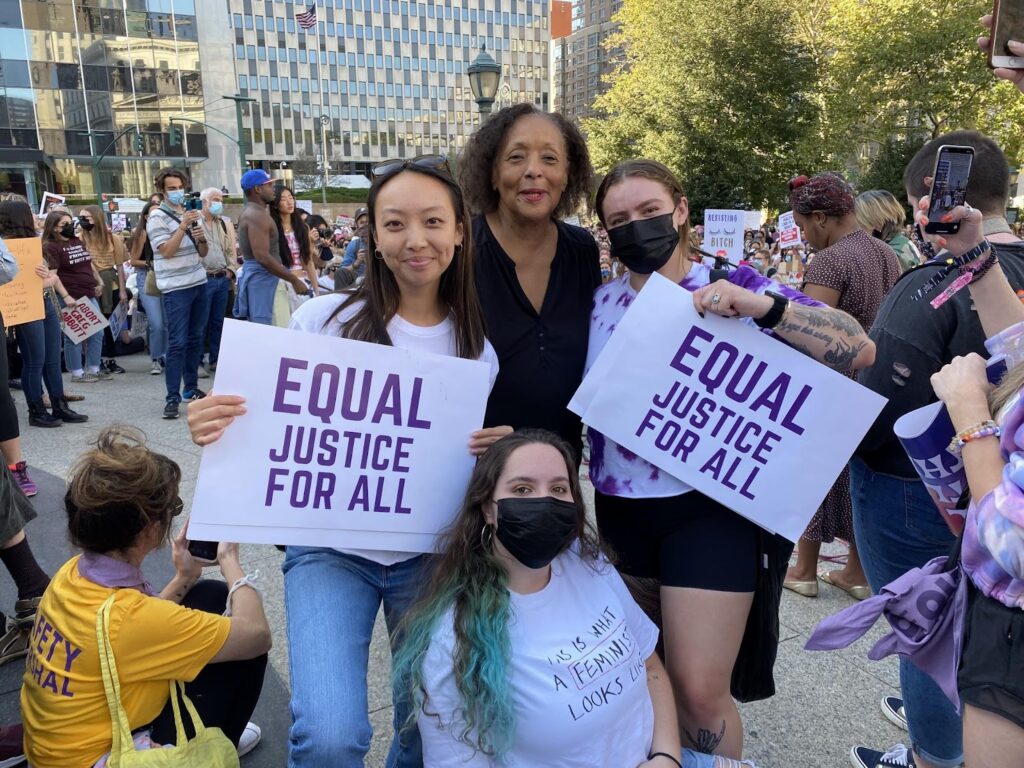
The Equal Rights Amendment has been in the works for almost 100 years. In 1972, the amendment passed in Congress. Now 50 years later, the required 38 states have voted to ratify the ERA—but it hasn’t yet been added to the U.S. Constitution after the Trump administration blocked the national archivist from certifying and publishing the ERA as the 28th Amendment. But no one is taking that as final.
Last month, Reps. Jackie Speier (D-Calif.), Carolyn Maloney (D-N.Y.) and 154 cosponsors introduced a resolution in the House of Representatives affirming the ERA has been validly ratified and is now in effect. President Biden also reiterated his strong support for the ERA and urged Congress to pass the resolution: “No one should be discriminated against based on their sex—and we, as a nation, must stand up for full women’s equality.”
Five generations have picked up the mantle of the ERA; grandmothers, mothers and daughters have marched together with the goal of seeing the ERA in the Constitution. With that goal now in sight, it is our responsibility to fully attain verifiable and recognizable constitutional equality between genders.
I’m 20 years old and a senior at Long Island University Global. In conversation with other Gen Zers, here’s why the ERA is important to us and how we see our role in the fight today.
Ms.: What does the ERA mean to you?
Sarah Farouq: The ERA means optimism to me. As a woman and youth of color growing up in the U.S., the ERA is my chance at an equitable future. It’s my chance for lawmakers and judges to hear me and take my demands seriously. I’ve had to stand up for myself and my community, advocating for basic rights and needs, such as access to quality healthcare and safety from systemic and interpersonal violence. All things that have been dimmed under the light of the law; things the ERA brings back to the forefront of conversation and policymaking.
The ERA isn’t simply about basic “equality,” it’s a permanent and powerful tool designed to uplift issues and policies from a gender-focused lens, a critical legal protection currently missing in our constitution. The ERA makes me optimistic about our future as a country. This amendment will be the backbone of revolutionary advocacy and social change for historically excluded communities.
Madison Gusler: To me the ERA will help establish equal rights between the genders, creating a space for equity and equality for all citizens of the United States and introducing a platform for further recognition of all gender identities as equally deserving of rights as human beings, no matter their sex. It will also help protect rights we have already been granted but have recently come under attack, such as access to abortion and contraception, equal pay and Title IX. The ERA will help protect women from sex-based discrimination that has become implicit in our courts, hospitals, schools and many other aspects of daily life.
Julia Squitteri: The ERA represents the convergence of what many women’s rights advocates have been fighting for. I’ve heard opponents of the ERA point to existing legislative initiatives for gender equality, such as Title IX, but these policies all too often fall short of the overarching change the ERA could usher in. Title IX prohibits discrimination on the basis of sex but is limited to educational institutions receiving federal funding. It is my conviction that the right to gender equity must not stop at the school door but extend to all people, which the ERA would accomplish.
While the ERA also carries symbolic purpose, I believe its true strength lies not in the short-term effect of its passage but the long-term. The ERA’s publication would prompt reconsideration of laws across the United States which still carry vestiges of gender discrimination, institutionalized in a framework rooted in the patriarchy.

Ms.: Why are you fighting for the ERA to be published and recognized in the Constitution?
Farouq: The ERA fight has often been framed around equal pay, which is one of many issues our communities face. However, the ERA not only deals with the workplace but creates organizing power and opportunity for equitable resource distribution in our society, shifting our priorities and values—from housing, healthcare and education to stopping police, partner and sexual violence. By expanding legal protections for people of all genders, we shift cultures and priorities. This is why we must publish the ERA.
Gusler: I am fighting for the ERA to be included in the Constitution because it is the only way to ensure our rights as women (and all other gender identities) to live and be recognized as equal to men is certified. When it is officially published in the Constitution, there is then reason to believe that those rights can not be denied for future generations.
Squitteri: When I founded the Ruth Project in 2020, it was the very night Justice Ruth Bader Ginsburg passed away. Every day since I’ve been propelled to fight for the ERA, not only because of my conviction of its necessity but also because Justice Ginsburg believed in its power to markedly improve the legal framework for gender discrimination.
Fighting for gender discrimination to be recognized in the U.S. legal system was Justice Ginsburg’s life’s work. In my work through the Ruth Project, the ERA remains a crucial component in the fight for gender justice. I want to live in an America where future generations don’t have to fight gender discrimination as my fellow feminists and I have had to. I want to see the ERA not just passed but fully implemented throughout our states to ensure equality.
Ms.: Why is this fight important to you?
Farouq: We need the ERA enshrined in our nation’s constitution to protect our communities from political harm happening on both sides of the aisle. Too often when a new administration inherits office, civil rights legislation becomes a bargaining chip or is swiftly overturned to make a statement. This instability damages long standing histories of struggle and compromises the safety of our most vulnerable communities. By making the ERA a permanent fixture of the constitution, we create a legal precedent that will endure no matter the party in office and take a vital step towards a more equitable, inclusive and care centered future.
Gusler: This fight is important to me for many reasons but the main ones being the history and its ability to impact the future for women. A close friend of my family worked alongside Bella Abzug and many others to advocate for the ratification of the ERA in New York in 1972. The history and connections made throughout generations, the fact that we are still fighting that same fight, always shocks me. The idea of this legislation changing the lives of women for decades to come, granting them further equality, is an exciting feeling and a great effort to be a part of.
Squitteri: I’m dedicating my life to social justice, and gender justice is an undeniable aspect of comprehensive social justice. I am not fighting for gender equality alone, but for gender equity and justice. The ERA is a step towards gender justice, but I do not believe we should strive merely for equality. The issue with “equality” alone is all too often it neglects an intersectional focus on women. What is seen as “equal” treatment for women is not always equitable for all who identify as women. It is especially important to recognize this with the ERA, which was written long before the term “intersectional” came around.
I think the ERA would be a huge victory for gender equality advocates. With that, we must also remember some women face more barriers to opportunity than others and it’s our duty to not let the fight for gender justice stop at the ERA, but instead meet the needs of our communities to foster inclusivity and true equity.

Ms.: What are you doing to help move the ERA forward?
Farouq: As community partnerships chair of The Feminist Front, a gender and racial justice organization committed to challenging systems of domination, I’m responsible for building a coalitional organizing effort to advance the Equal Rights Amendment. Our youth-justice lens sees value in bringing intergenerational partners to the ERA fight where so many critical issues come together. Another important part of our #ERANow campaign is focused on cultivating greater political consciousness amongst our peers. Through workshops, videos and gathering petition signatures, we have connected youth across the country with meaningful opportunities to contribute in the fight for gender justice. Youth today have voiced their fierce support of the ERA and believe that after almost one hundred long years, we are the generation to finally get it published.
Gusler: I currently work for the ERA Coalition to help create social media content about the Equal Rights Amendment. I aim to raise awareness about the amendment and its history, as well as gender-based discrimination, among the younger generations who might not be as aware or involved in the fight for the ERA. I try to communicate the importance of the ERA to Gen Z and remind people about the fight that is currently occurring, informing them on the ways they can help. Such as signing our petition, seeking ratification of the ERA in their own state, getting involved with the ERA Coalition’s events and more. This position includes a lot of research which I communicate through posts, but also by writing about the ERA for Ms. magazine.
@eracoalition Sign our petition to get rid of that ONE PIECE OF PAPER #genderequality #eracoalition #eranow #fyp #womensrights #equalrightsforall #equalrights ♬ lana del rey rainha – lorenna
Squitteri: If you ask any teenager what the ERA is, unfortunately you will likely be met with a blank stare. This is a huge problem if we want to get the ERA passed—and at the Ruth Project, we’re working to find the solution. Awareness goes a long way regarding the ERA, so we strive to inform our audiences via social media and encourage them to educate others. We’re also working to reform Title IX offices, which are crucial when it comes to guaranteeing students their right to gender equity. Advancing related legislation helps build frameworks that can support larger, more comprehensive bills like the ERA.
President Biden has called on Congress to pass the ERA, but the Senate filibuster poses concern for the legislation’s fate. Assuming the filibuster isn’t abolished in coming months, the ERAs success will likely depend on the 2022 midterm elections. The ERA can be a huge motivating factor for women to vote— but first they need to know about it. If feminists across the United States work to educate those around us on the ERA, why it matters and why they should vote to support candidates endorsing the ERA, we can surpass the required support in the U.S. Senate to pass the ERA once and for all.
Up next:





